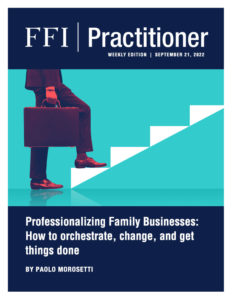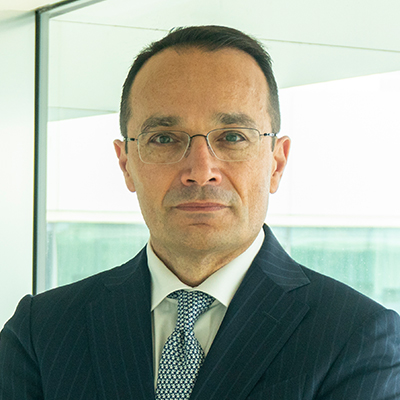
View this edition in our enhanced digital edition format with supporting visual insight and information.
In this week’s FFI Practitioner, Paolo Morosetti addresses the topic of family enterprise professionalization. In his article, Paolo provides an overview of what it means to professionalize a family enterprise (and perhaps more importantly, what it does not mean) and shares the examples of two Italian families who took different approaches to professionalizing their businesses.
Family enterprise professionalization is good for both the family and the business. It requires making deliberate decisions to change the configuration or functioning of key governance and organizational components, such as the board of directors, organizational structure, culture, systems, processes, and people. Its purpose is to create a high-performing company that is less personality-driven, is prepared for transformation or scaling where needed, and is attractive to talent based on merit rather than birthright or affinity.
Orchestrate: Adopting a systemic and holistic approach
Decisions aimed at professionalizing family enterprises make up a system of interrelated actions and should be made holistically. For example, some families undertake sophisticated governance changes without proper adjustments for people, structure, and processes, resulting in failure to achieve the expected results or, even worse, damage to the initial levels of organizational effectiveness and efficiency.
Others confuse professionalization with simply hiring talent from outside of the family. Such strategies will likely end in failure, triggering two effects. On one hand, failures could confirm the suspicions of those who are skeptical of the professionalization of family businesses. Their frustrations could also echo in the family business community, sparking so-called conformity bias: family business owners could follow the herd rather than use their independent judgment. On the other hand, initial failures can also lead companies to give up too quickly and, paradoxically, paralyze their organizational development at the expense of their continuity.
It is worth noting that changing one component at a time is typical when risk-averse leadership and family culture are comfortable with incrementalism and prudence.
Looking at professionalization as a multi-step, interconnected process calls for leadership familiar with system theory and holistic principles in management. This approach is process-based, brings clarity and alignment to both family and business, and avoids concentrating on an isolated frame rather than obtaining a panoramic view of the situation that needs to be orchestrated.
One myth to debunk on this matter is that professionalization entails removing the family from the business. Familiness—when it is an asset, not a roadblock—is a valuable source of competitiveness that can be nurtured in the family and funneled into the company. Qualified family directors, executives, and employees can convey family uniqueness in business and promote cross-pollination between the family and business cultures, as well as during transition towards professionalization.
Change: When the time is right
Debate on professionalization is inevitable when the growth of a business generates complexity or when a transition from one generation to another generation occurs. Consider the case of Salvatore Ferragamo. In the 1990s, the family began to professionalize their company to face the challenges that had arisen mainly due to industry dynamics, as described in a famous case study.1 In 2006, the second generation pulled back from day-to-day operations and hired the first non-family CEO, who promoted broad professionalization to go public. Today, Salvatore Ferragamo is still engaged in professionalization in order to stay ahead of the curve as a high-performing organization. This kind of process is iterative and continues in waves.
Look now at the case of a medium-large Italian family business competing in the steel industry. In 2018, the company performed very well with a simple and efficient organizational design, a governance model mirroring family shareholders’ interests, and leadership in the hands of two brothers acting as co-CEOs for decades. Both the financial and the human resources systems were centrally managed by the co-CEOs, who also kept information and performance indicators hidden, with the downside of making accountability a judgment, not a measurement. As a result, senior management were well-qualified from a technical point of view and great executors of family desires but had limited powers or managerial authority. A few members of the third generation were employed in the business but were not yet in key positions. In 2018, one of the two brothers died unexpectedly and the other was diagnosed with a mental illness shortly after. These events brought great sadness to the family and, along with it, worries and concerns about the future. Succession suddenly became a topic of conversation instead of being taboo, as it had been for years, and the family courageously established a Nextgen Committee to craft a new owners’ strategy. The third generation spent six months in meetings and discussions, which ended with the unanimous approval of a strategic plan in which one of the priorities was professionalizing the family business so as not to be dependent on key qualified members (family and non-family).
Unlike Salvatore Ferragamo, this second example shows how family and ownership dynamics may trigger change. Recognizing the transience of human existence can push families to move from a “family managed business” to a “professionally managed business.”
SIDEBAR
By: Claudia Astrachan, Matthias Waldkirch, Anneleen Michiels, Torsten Pieper, and Fabian Bernhard
This research report, sponsored by the FFI 2086 Society, hopes to inspire controversial discussions among business families, their advisors, and other stakeholders. The report challenges readers to question their beliefs on how to best support families in their quest to professionalize, looking beyond formal means of professionalization and governance.
Get Things Done: Breaking barriers to change
Any company can professionalize through adaptation to change processes, but this is often complicated—people do not modify their behavior and routines naturally or immediately, even if events unquestionably demand it. The professionalization process can feel more personal and emotional in the family business than in other companies, as several change-related hurdles are more pronounced in family businesses.
In the case of Ferragamo, the family hired an external consultant in the 1990s to diagnose the need for change and recommend actions to face their issues. The family interpreted the report issued by the consultant based on their long-term orientation and strong emotional attachment to the company, with the effect of not implementing all the suggested actions. Needs for change were likely overlooked because emotional and cognitive barriers interfered in the phases of recognition and interpretation. At that time, Wanda Ferragamo and her six siblings still worked in the business and firmly controlled the governance, leadership, and organization.

In the case of the steel company, the next generation had recognized and interpreted the unsustainability of the situation well before tragic events occurred, but they were not allowed to voice their opinions while the senior generation was in command. When the context evolved, they made quick decisions that were less influenced by the emotional and cognitive barriers of the parents. However, the implementation phase was not as easy as they had expected. One of the critical decisions was appointing a high-caliber managing director, an outsider, to replace the diarchy of the two co-CEOs. This change took place on paper only because the family hesitated to give up power. Working behavior and routines did not evolve, the family delegitimized the new position, and the new hire had to leave the company after six months.
Meaningful lessons can be learned from these two examples and many similar cases. First, when making sense of professionalization, it is important for the family to recognize and try to work through skewed perceptions or myopia as regards the need for change. Specific techniques to overcome barriers and bias should be implemented swiftly. Second, to be effective, this process needs to revise the network of social relationships within the company. If the family can accept the abdication of its central and unique role in nourishing social capital, non-family employees can have the chance to modify the configuration of the network, the shared language, and the narrative, which can build trust, a sense of belonging, and greater sense of responsibility for the new design. Third, professionalization calls for a willingness on the part of the family to compromise their socio-emotional wealth, commit adequate resources to achieving change, and be patient so as to reap the benefits later. Quick wins in professionalization are significant, but not necessarily essential, as this process impacts many governance and organizational variables.
What can family business advisors do to get professionalization right?
- Educate the family on the principles of a systematic and holistic approach.
- Support the family in understanding their important role in a professionally managed company. Through the process of professionalizing, how can a family business still maintain its unique “familiness” to avoid becoming like any other non-family business?
- Help reconcile the old and the new and overcome emotional and cognitive barriers during the process.
- Encourage patience when necessary, support the family in providing clarity, and periodically remind them of the purpose of this process—to build a high-performing organization for future generations.
Reference
1Salvatore Ferragamo, SpA. (1998). Family Business Review. 11(2):145-163. https://doi.org/10.1111/j.1741-6248.1998.00145.x
About the Contributor

Paolo Morosetti is a senior lecturer at Bocconi University in Milan, Italy, where he teaches corporate strategy and strategic management of family businesses. Paolo has also served as the director of the Strategic and Entrepreneurial Management Department at Bocconi. Paolo also advises family business around the world, focusing on generational transitions, family and business governance, strategy, and next generation leadership development. He also serves as a board member for several multi-business and multi-national firms and is a speaker and moderator at conferences on topics related to family business strategies. Paolo is a co-author of the book Corporate Strategy for a Sustainable Growth published in 2020. He can be reached at paolo.morosetti@unibocconi.it.

View this edition in our enhanced digital edition format with supporting visual insight and information.





